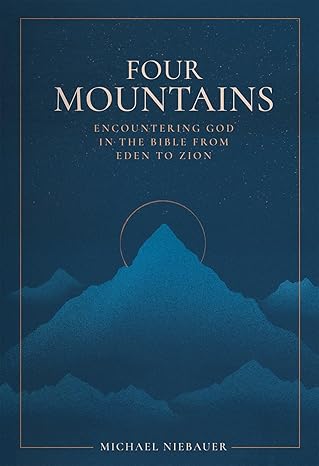A Brief Book Notice from Books At a Glance
by Fred G. Zaspel
The Bible is a story with a narrative arc; it has a beginning, middle, and end. Today, there is a renewed interest in reading the Bible in a linear fashion that pays careful attention to its development and progress. This is good, but we also need to see how certain symbols bind the individual books of the Bible together into a united whole. Scripture contains symbols that remind us of Jesus and how we relate to God through faith in him. One symbol that connects virtually the entire Bible from beginning to end is the symbol of mountains. In Scripture, mountains are key locations where God meets with individuals to display his glory. The relationship between Mount Eden, Mount Sinai, Mount Tabor, and Mount Zion is important and will anchor this study. One of the benefits of learning how to interpret biblical symbols is that it provides coherence and structure to our understanding of the whole Bible, but it also allows us to benefit from parts of Scripture we may struggle with when taken on their own. Tracing out the mountain symbolism in Scripture tells God’s story of redemption.
Table of Contents
1. Story and Symbol
Part 1: The Story of Mount Eden
2. God Creates
3. Mount Eden
4. The Fall from Mount Eden
5. The False Mountain of Babel
Part 2: The Story of Mount Sinai
6. Abraham
7. Out of Slavery and into the Wilderness
8. Life and Law on Mount Sinai
9. The Tabernacle
10. The Prophets Prepare
Part 3: The Story of Mount Tabor
11. Jesus Descends
12. Jesus Ascends
13. The Crucifixion
14. The Resurrection
Part 4: The Story of Mount Zion
15. The Ascension
16. Pentecost
17. Mount Zion
18. Climbing the Spiritual Mountain
19. Climbing the Physical Mountain
20. The Bible and Our Climb
21. Our Final Climb up Mount Nebo
Quote & Unquote
- Similarly, the Bible introduces the setting, main characters, and major themes in just the first two chapters of Genesis. What is fascinating about Genesis 2 is that it is both the beginning of the story of Mount Eden and, at the same time, a microcosm of the entire biblical story. (34)
- But there is a deeper meaning behind the assertion that Adam and Eve were naked and felt no shame. They were not ashamed because God’s glory was their clothing. (46)
- We exchange the beauty of creation for the blunt dullness of man-made things; brick and mortar become our mountains. Rather than longing to return to the mountain of God, we’ve made our home in this sinful world, worshiping material things and glorifying ourselves. Such is life east of Eden. (67)
- If the mountain is meant to be a place where we are at home with God our maker, Babel is an attempt to find our home entirely apart from God. (74)
- We will proceed by taking a brief snapshot of these various scenes from Abraham’s journey, showing how his story and the symbols he encounters invite us to see Jesus and ourselves in the pages of Abraham’s life. (85)
- In the following three chapters, we will walk through the major events in the life of Jesus, showing how he fulfills the stories of Mount Eden and Mount Sinai and the symbols associated with them. (157)
- The Psalms declare that Jesus’s return will be like rain pouring down on a mown field (Psalm 72:6). The rivers of life will saturate and nourish the earth, turning its grounds into the paradise of Mount Zion. (229)
- The mission of Adam and Eve was to expand the borders of Mount Eden so that the whole world would be filled with God’s presence. When Christians go out on mission and establish new congregations, they are participating in this primordial mission. (245)
- We are reminded that the hardships of this life will one day come to an end, that the glorious presence of God that we experience on the mountain will one day be the norm rather than the exception. (309)
